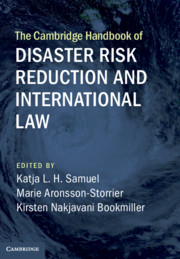19 results
Foreword
-
- Book:
- The Cambridge Handbook of Disaster Risk Reduction and International Law
- Published online:
- 15 February 2019
- Print publication:
- 28 February 2019, pp xv-xvi
-
- Chapter
- Export citation
Part II - Communication, Early Warning Systems, and DRR
-
- Book:
- The Cambridge Handbook of Disaster Risk Reduction and International Law
- Published online:
- 15 February 2019
- Print publication:
- 28 February 2019, pp 129-216
-
- Chapter
- Export citation
Part III - Regional and National Approaches
-
- Book:
- The Cambridge Handbook of Disaster Risk Reduction and International Law
- Published online:
- 15 February 2019
- Print publication:
- 28 February 2019, pp 217-312
-
- Chapter
- Export citation
Part VI - Catastrophic Events and DRR
-
- Book:
- The Cambridge Handbook of Disaster Risk Reduction and International Law
- Published online:
- 15 February 2019
- Print publication:
- 28 February 2019, pp 443-498
-
- Chapter
- Export citation
Part V - Health, Cultural Property/Natural Heritage, and DRR
-
- Book:
- The Cambridge Handbook of Disaster Risk Reduction and International Law
- Published online:
- 15 February 2019
- Print publication:
- 28 February 2019, pp 371-442
-
- Chapter
- Export citation
Contents
-
- Book:
- The Cambridge Handbook of Disaster Risk Reduction and International Law
- Published online:
- 15 February 2019
- Print publication:
- 28 February 2019, pp v-vii
-
- Chapter
- Export citation
Figure and Tables
-
- Book:
- The Cambridge Handbook of Disaster Risk Reduction and International Law
- Published online:
- 15 February 2019
- Print publication:
- 28 February 2019, pp viii-viii
-
- Chapter
- Export citation
Table of Cases
-
- Book:
- The Cambridge Handbook of Disaster Risk Reduction and International Law
- Published online:
- 15 February 2019
- Print publication:
- 28 February 2019, pp xix-xx
-
- Chapter
- Export citation
Contributors
-
- Book:
- The Cambridge Handbook of Disaster Risk Reduction and International Law
- Published online:
- 15 February 2019
- Print publication:
- 28 February 2019, pp ix-xiv
-
- Chapter
- Export citation
Index
-
- Book:
- The Cambridge Handbook of Disaster Risk Reduction and International Law
- Published online:
- 15 February 2019
- Print publication:
- 28 February 2019, pp 499-510
-
- Chapter
- Export citation
Preface
-
- Book:
- The Cambridge Handbook of Disaster Risk Reduction and International Law
- Published online:
- 15 February 2019
- Print publication:
- 28 February 2019, pp xvii-xviii
-
- Chapter
- Export citation
Part I - International Law Framework and DRR
-
- Book:
- The Cambridge Handbook of Disaster Risk Reduction and International Law
- Published online:
- 15 February 2019
- Print publication:
- 28 February 2019, pp 15-128
-
- Chapter
- Export citation
Copyright page
-
- Book:
- The Cambridge Handbook of Disaster Risk Reduction and International Law
- Published online:
- 15 February 2019
- Print publication:
- 28 February 2019, pp iv-iv
-
- Chapter
- Export citation
Part IV - Air, Sea, and DRR
-
- Book:
- The Cambridge Handbook of Disaster Risk Reduction and International Law
- Published online:
- 15 February 2019
- Print publication:
- 28 February 2019, pp 313-370
-
- Chapter
- Export citation
Abbreviations
-
- Book:
- The Cambridge Handbook of Disaster Risk Reduction and International Law
- Published online:
- 15 February 2019
- Print publication:
- 28 February 2019, pp xxi-xxviii
-
- Chapter
- Export citation

The Cambridge Handbook of Disaster Risk Reduction and International Law
-
- Published online:
- 15 February 2019
- Print publication:
- 28 February 2019
List of contributors
-
-
- Book:
- Volcanism and Global Environmental Change
- Published online:
- 05 February 2015
- Print publication:
- 08 January 2015, pp viii-xii
-
- Chapter
- Export citation
Contributors
-
-
- Book:
- Pediatric Emergency Critical Care and Ultrasound
- Published online:
- 05 February 2015
- Print publication:
- 24 April 2014, pp x-xii
-
- Chapter
- Export citation
Contributors
-
-
- Book:
- Statehood and Self-Determination
- Published online:
- 05 March 2013
- Print publication:
- 21 February 2013, pp viii-xiv
-
- Chapter
- Export citation



